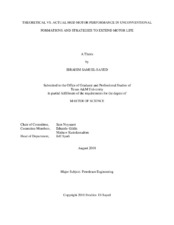| dc.description.abstract | The continued growth in unconventional drilling has pushed motors to drill more complex geometries, drill faster, and drill at higher well temperatures. The most common method to postpone motor failure has been to select a larger motor. This option ignores the root causes of motor failure and would leave performance on the table. Impetus for this work centered around an operator in the Eagleford who was experiencing high rates of motor failure. In the process of investigating the failures, important findings were made that apply to any BHA with a motor.
Motor properties are used to convert the traditional surface MSE measurement into a more representative bit MSE. Bit MSE is calculated using, a simple factor and a more exact but complicated multi-dimensional correlation. Drilling data is used to show that the simplicity of the simple factor more than offsets minor loses in MSE accuracy. The realtime RPM factors are also computed using downhole data showing the stark differences between the actual factors and the originally reported factors. The difference is used to determine the degree of motor damage while drilling.
A suite of downhole sensors are placed above and below the motor to monitor the rate of motor damage. Differential pressure is also analyzed in the frequency domain spectrum to demonstrate the damaging effect of bottomhole assembly (BHA) whirl during rotating. However, bit MSE does not provide an accurate indication of the degree of whirl occurring in the motor. Rather, a BHA must be engineered to minimize motor vibrations and damage. Correspondingly, an empirical equation is derived to predict the fundamental differential pressure frequency of a motor.
The use of depth of cut control (DOCC) is analyzed as a method to improve motor efficiency and decrease damage. Two identical wells and BHA’s are compared, one with and one without DOCC. The uses of the first derivative of differential pressure is suggested as a method to better quantify and visualize the effects of DOCC. Ultimately, the research presented provides quantitative insights into the operation of a motor, and changes are proposed to improve motor life based on the observed data. | en |


